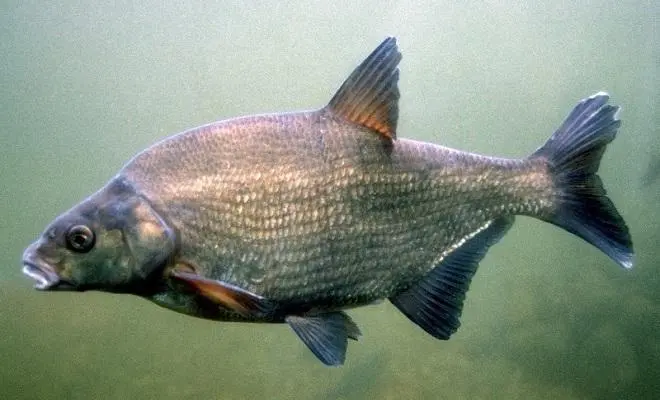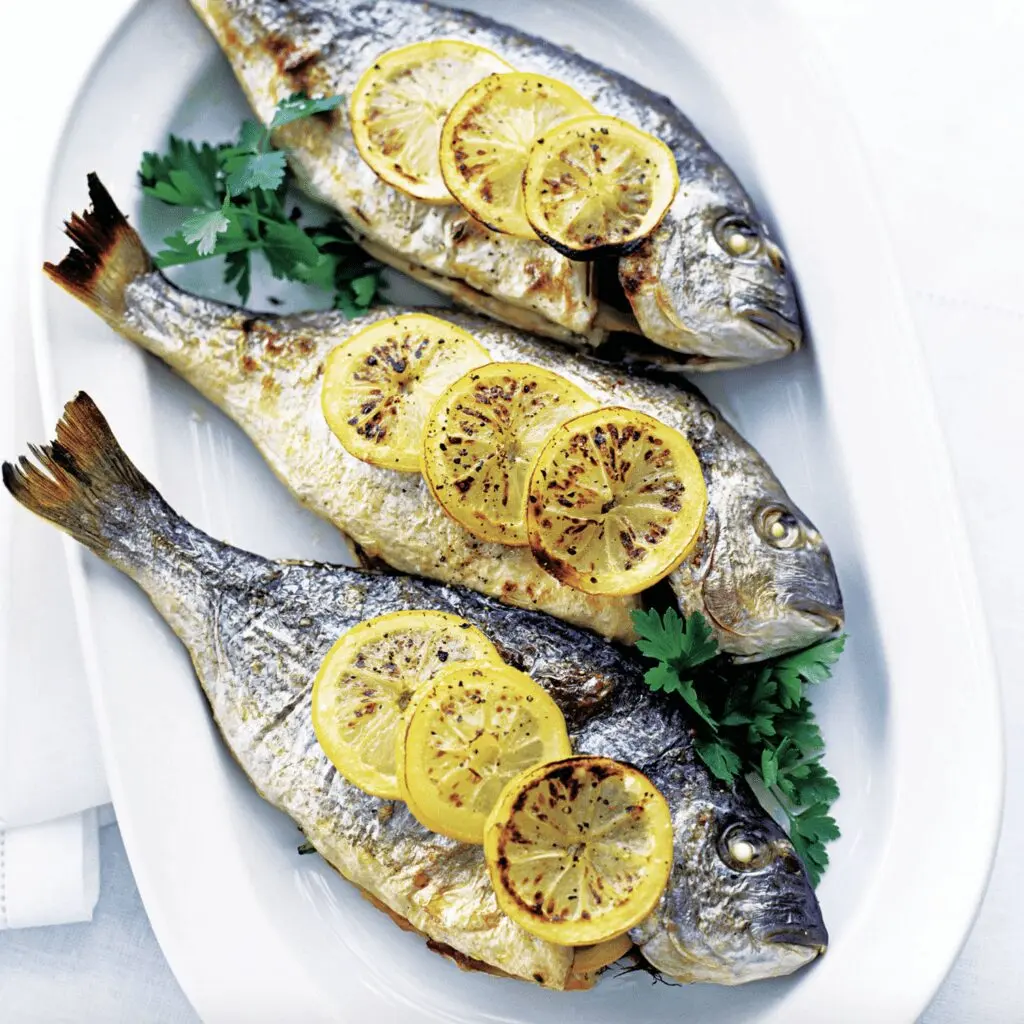Contents
Description of bream
Bream is a relatively large fish with a high body compressed from the sides. The head and eyes are relatively small. The back behind the occiput rises sharply upward, forming a “hump,” especially in large individuals.
The color of the young is gray-silver, the large are brownish with a golden tint. The mouth is semi-inferior, small, but can protrude strongly, forming a long tube directed downward. Behind the pelvic fins, the keel is not covered with scales, but there is a furrow free of scales in front of the dorsal fin.
It differs from blue bream and white-eye in a smaller number of branched rays in the anal fin and a smaller number of vertebrae. The beginning of the dorsal fin is above the middle of the vertical between the ventral and anal. The anal is high and starts behind the end of the dorsal base.
How long does it live?
Bream lives up to 20 years, but usually up to 12-14 years. It can reach a length of 75-80 cm and a weight of 6-9 kg. The usual dimensions are 25-45 cm and a weight of 0.5-1.5 kg. Recently, 7-8 geographic groups have been distinguished throughout the entire range of the species.

Bream habitats
Bream adapts well, so the fish lives in a deep natural and artificial reservoirs. It lives at the bottom. In particular, it prefers channels, creeks, deep natural pits, open-pit mines with a soft bottom.
Interesting to know! During the winter, poachers through an ice-hole extract whole families of bream from the water, which prefer to winter in heaps, hiding in deep holes.
Breams can also live in drying up water bodies, in which zones with aquatic vegetation are preferred. Found in Europe, Asia and America.
- Calorie content 105kcal
- Energy value of the product (Ratio of proteins, fats, carbohydrates):
- Proteins: 17.1g. (∼ 68.4 kcal)
- Fat: 4.4g. (∼ 39.6 kcal)
- Carbohydrates: 0g. (∼ 0 kcal)
- Energy ratio (p | f | c): 65% | 37% | 0%
Bream fillet composition
The composition of bream includes important components involved in metabolic processes. 100 g of fillet of bream contains about 220 mg of phosphorus, 250 g of potassium, and 165 g of chlorine.

Also, from the composition of delicious fish, our body will receive:
- Trace elements: magnesium, calcium, nickel, sodium.
- Vitamins: A, C, B, E, D.
- Amino acids, including Omega-3 and Omega-6.
- Interesting to know! In terms of fat content, bream is second only to beluga. Fish fillets from the nursery contain about 9% fat. In small fish, the flesh is dry and filled with bones, which significantly reduces its value. The most useful is the bream caught in the autumn in the Sea of Azov.
Also, fish contains about 20% protein, which allows you to use bream during diets and sports.
Useful properties of bream fillet
- During heat treatment, the bream fillet loses omega-3 and 6 acids, so the fish is best to steam\, grill, or use as a nutritious broth. But all this is not so important compared to the beneficial effects that this fish pulp has on the body:
- Strengthens the muscle corset due to its high protein content.
- Omega-3 and 6 acids contribute to the normal functioning of the gastrointestinal tract, support the body after a serious illness or injury.
- Bream fat is also beneficial: it cleans blood vessels, especially if consumed in its pure form.
- The content of vitamin D and A will allow you to get rid of problems with low vision and overcome childhood rickets. In addition, vitamin D helps to strengthen hair and nails, which will appeal to every beauty.
Important! Representatives of the Institute of Nutrition declare that fatty acids Omega-3 and Omega-6, contained in excess in bream, break down cholesterol plaques. No plaque – no coronary artery disease and obesity. Therefore, bream is one of the healthiest types of fish.
Harm
Bream is a harmless fish, but people who are allergic to fish and seafood should refuse it. And if you give bream to a baby under 5 years old, then the fish should be stewed for at least 1-1.5 so that the bones soften and do not harm the child.
How to choose and store bream?

When choosing a bream, pay attention to its appearance:
- Gills and carcass without mucus.
- “Wet” eyes and scales. Dry scales indicate that the fish is stored outside the reservoir for 3-4 days.
- Bream smells like water, but a rotten, pungent aroma indicates old age and low-quality fish.
- The most delicious bream weighing from 1 to 2 kg, small individuals are bony, and large ones are too fat.
- You can store fresh bream in the refrigerator for 2-3 days, free of gills and scales. The cleaned fish is well stored in the freezer for 1 to 4 months.
Bream in cooking

There are more than 50 ways to prepare bream because it is baked with cheese and olive oil, fragrant herbs, and spices. Bream is also good as an ingredient for hunting fish soup: it will give the dish the desired fat content.
Advice! When baking Bream, do not separate the head from it: put 2 cloves of garlic in the gills, sprinkle the carcass with lemon juice, and put grated cheese inside the fish. Put everything on a baking sheet and after 30-40 minutes. The dish is ready. Serve the baked bream with a glass of white wine and lemon wedges to hide the “fishy flavor.”
You can also cook from bream:
Fish cakes or dumplings by twisting the cut bream carcass 2 times in a meat grinder. You can cook from the minced meat!
Bream with mushrooms

Ingredients:
- Bream – 1-1.5 Kilograms
- Onions – 3 Pieces
- Champignons – 400 Grams
- Lemon – 1 Piece
- Salt – any To taste
- Black pepper – any To taste
- Coriander – any To taste
- Vegetable oil – 100 Milliliters (for baking)
Servings Per Container: 4-6 Details:
Cooking
- Wash, clean, removed from all entrails the fish. Wash again and make small cuts on the side. There should be about 20 of them.
- Then it would help if you took salt, pepper, coriander and mix everything thoroughly.
- After mixing spices, take the bream and rub it well with this mixture. Leave the fish for 40-60 minutes, so the bream can “marinate.”
- Put the bream aside and start practicing onions. I clean the onion, wash it, cut it into small cubes and fry it in vegetable oil. You need to fry until golden brown.
- Then proceed to the mushrooms. Wash them under running water, cut them lengthwise, fry them. Like onions, mushrooms should take on a golden hue.
- As soon as the mushrooms are ready, mix them with the onions. Transfer the finished filling into the belly of the bream.
- To prevent the filling from falling out of the fish.
- Then take a lemon, cut it into half rings and put two slices of bream by the gills. Lemon gives the dish a slight sourness, which only improves the taste of the fish.
- Now it remains only to wrap the tail of the bream in a piece of foil so that it does not burn out during baking.
- Everything is ready for baking. On a preheated baking sheet greased with vegetable oil, I shift the bream and put it in the oven. You need to bake for about 30 minutes at 180 degrees. After 30 minutes, grease the fish with mayonnaise and leave to bake for another 10 minutes.
- After 40 minutes, select the bream, and in the cuts make at the beginning of cooking, insert the halves of lemon. Leave the dish for another 5 minutes in the oven and only then serve it to the table.










هناك اخطاء في النص لجهة ادراج غرام مكان ملج. اقترح التصحيح